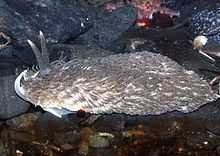Aeolidia papillosa
| Aeolidia papillosa | |
|---|---|
 | |
| A live individual of Aeolidia papillosa, head end towards the left | |
| Scientific classification | |
| Kingdom: | Animalia |
| Phylum: | Mollusca |
| Class: | Gastropoda |
| (unranked): | clade Heterobranchia clade Euthyneura |
| Superfamily: | Aeolidioidea |
| Family: | Aeolidiidae |
| Genus: | Aeolidia |
| Species: | A. papillosa |
| Binomial name | |
| Aeolidia papillosa (Linnaeus, 1761) | |
Aeolidia papillosa is a species of sea slug, an aeolid nudibranch, a marine gastropod mollusk in the family Aeolidiidae. A. papillosa has many common names including the shaggy mouse nudibranch or the shag rug nudibranch, in part due to its shape and its numerous flattened cerata that make it look rather like a bedraggled mouse[1] or like a shag rug.

Distribution
This nudibranch species lives on the Atlantic coast of The British Isles and Northern Europe, the Atlantic coast of North America, and the Pacific Coast of North America. It also appears to occur on the west and east coast of South America.[1]
Description
Aeolidia papillosa can be easily identified by its large number of flattened cerata on its body except for a triangular area that extends from the rhinophores to the mid dorsum. The cerata vary in color from grey to white and sometimes pink, orange, or green hues, depending on the species of anemone it has been feeding on. Though sometimes smaller, this species can grow to a length of 10 cm(4 in) in the Pacific Ocean and up to 12 cm(5 in) in the Atlantic Ocean.[2] The maximum recorded length is 100 mm.[3]
Ecology
Habitat
The minimum recorded depth for this species is 0 m; the maximum recorded depth is 380 m.[3]
Feeding habits

Although sea anemones are a component of most nudibranch’s diet, Aeolidia papillosa feeds almost entirely on various species of anemones. However, due to limited mobility of nudibranchs and often highly concentrated distribution of prey, individual nudibranchs may concentrate on an individual species of prey during their lifetime.[4] These nudibranch feed mostly feed on the tentacles of the sea anemone.
Protozoan symbiosis
Aeolidia papillosa has been shown to harbor the symbiotic organisms of sea anemones, which may increase nutrient production.[5] Zooxanthellae and zoochlorellae are endosymbiotic organisms found in many sea animals that fix carbon through the process of photosynthesis while contributing greatly to their host’s growth. Research has shown that these symbionts continue to perform high levels of photosynthesis and remain in Aeolidia papillose’s cerata for as much as eleven days, translocating a significant amount of fixed carbon to the nudibranch’s bodily tissues.[5]
Defense
It has also been revealed that a number of aeolid nudibranchs, including Aeolidia papillosa, are able to encase undischarged (nematocysts) within a phagosome which are then stored as newly formed kleptocnidae in muscularized chambers, called cnidosacs, which are located at the tips of the cerata. These cnidosacs are capable of ejecting the kleptocnidae when under threat or attack.[6][7]
Chemical manipulation of prey
A unique phenomenon displayed by Aeolidia papillosa has been studied, revealing an ability to prevent the species of anemone being preyed upon from discharging its nematocysts. A. papillose appears to have the ability to adapt to the species of anemone currently being consumed. Though the mechanism is not yet fully understood, the chemical composition of the nudibranch's mucus changes, and does not trigger a discharge of nematocysts in the sea anemone. This effect can even be true for two different species of anemone if the nudibranch has been feeding on both species within a short time period. However, eventually this ability wears off if the nudibranch changes its dietary source for too long.[4]
References
- ↑ 1.0 1.1 Behrens, D. W., 1980, Pacific Coast Nudibranchs: a guide to the opisthobranchs of the northeastern Pacific, Sea Challenger Books, Washington
- ↑ http://zipcodezoo.com/Animals/A/Aeolidia_papillosa/
- ↑ 3.0 3.1 Welch J. J. (2010). "The "Island Rule" and Deep-Sea Gastropods: Re-Examining the Evidence". PLoS ONE 5(1): e8776. doi:10.1371/journal.pone.0008776.
- ↑ 4.0 4.1 Greenwood, Paul G.. "Adaptable Defense: A Nudibranch Mucus Inhibits Nematocyst Discharge and Changes With Prey Type Biological Bulletin 206. 2 (2004), 113-120, http://www.jstor.org/stable/1543542. (accessed April 21, 2010)
- ↑ 5.0 5.1 McFarland, F. K.. "Photosynthesis and Retention of Zooxanthellae and Zoochlorellae within the Aeolid Nudibranch Aeolidia papillosaBiological Bulletin 184. 2 (1993), 223-229, http://www.jstor.org/stable/1542230. (accessed May 10, 2010)
- ↑
- Martin, Rainer. "Cnidosac morphology in dendronotacean and aeolidacean nudibranch mollusks: from expulsion of nematocysts to use in defense?Springer-Verlag (2008), (accessed May 12, 2010)
- ↑ Lamb, Andy. Marine Life of the Pacific Northwest a Photographic Encyclopedia. Library and Archives Canada Cataloguing in Publication. Madeira Park, BC: Harbour Publishing, 2005
External links
| Wikimedia Commons has media related to Aeolidia papillosa. |